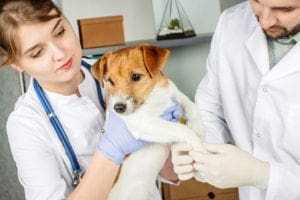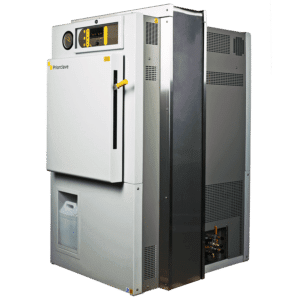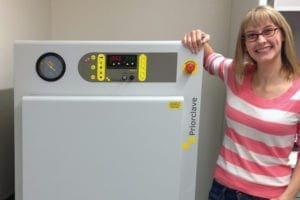Autoclave Sterilization for Veterinary Medicine and Veterinary Clinics

Veterinary medicine and research combine the rigors of working in a research lab with complexity of working in healthcare. But you must do so for eight or more different species, most of whom are uncooperative. And you need to do it on a much tighter budget.
Veterinary clinics and research facilities rely on steam autoclaves to prevent cross-contamination and to protect the health and safety of their animals and staff. Their autoclaves ensure that the surgical instruments, medical tools, and materials used in veterinary procedures are free from bacteria, viruses, microorganisms, active spores, and other pathogens.
Unfortunately, most autoclaves sold in North America are optimized for medical settings and doctor’s offices. They are excellent at quickly sterilizing clean medical instruments. But they do so at a high cost: they are expensive to purchase and operate, have high ongoing maintenance costs, and consume obscene amounts of electricity and water (even when sitting idle).
The ideal veterinary autoclave should be optimized for reliability and efficiency in a veterinary setting. That means an emphasis on performing the tasks most commonly needed in veterinary practice and research, with a flexible control system that can meet the wide range of uses that present themselves in veterinary medicine—without forcing you through a series of nested menus every time you want to run a simple cycle and get on with your day.
Such an autoclave meets your specifications because it is built to your specifications.
Sterilization in Veterinary Medicine
Steam sterilization is clearly vital to ensuring that veterinary instruments and medical supplies are free from potential pathogens and biological contaminants. But for many veterinary clinics and labs, their sterilizer serves an equally critical role: processing potentially infectious “red bag” waste.
 Throughout North America, any waste that may have had contact with blood, body fluids or other potentially infectious materials falls under the definition of “regulated medical waste.” Such waste is subject to regulation by OSHA, US EPA, The US Department of Transportation, Canadian medical waste legislation, State/Provincial regulations, and occasionally local or municipal ordinances. There can even be issues with private waste hauling companies.
Throughout North America, any waste that may have had contact with blood, body fluids or other potentially infectious materials falls under the definition of “regulated medical waste.” Such waste is subject to regulation by OSHA, US EPA, The US Department of Transportation, Canadian medical waste legislation, State/Provincial regulations, and occasionally local or municipal ordinances. There can even be issues with private waste hauling companies.
Importantly, “regulated medical waste” isn’t limited to materials potentially contaminated with human body fluids. It includes waste generated during veterinary procedures and animal research.
Medical waste must be treated before disposal to reduce the risk of infection. Veterinary clinics and hospitals once favored incineration for medical waste processing. Incineration is unquestionably effective. But given the amount of moisture present in medical waste, it is far from efficient, requiring extremely high temperatures and a constant flow of air through the incinerator. On top of that, burning medical waste releases mercury, dioxins, and other toxins. That creates significant hazards for workers, as well as those living and working nearby.
Incineration has been widely discouraged since the 1990s. Most organizations that need to process medical waste have shifted to other sterilization methods. Autoclave-based steam sterilization, which uses pressure and temperature to render waste sterile, has been among the most popular. The autoclave-based sterilization process has many advantages. Because it uses steam, the moisture content of medical waste is not an issue, allowing for far more energy efficient operation. Additionally, because the autoclave chamber is sealed, the potential for exposure to toxins is greatly reduced.
Veterinary Steam Autoclave Users
Around the world, veterinarians and those working in veterinary medicine and research rely on efficient, affordable Priorclave autoclaves. In the UK, where Priorclave was founded and is headquartered, labs for the Animal and Plant Health Agency (APHA)—the primary agency tasked with safeguarding animal and plant health for the benefit of people, the environment, and the economy—have long relied on benchtop, midsize, and large freestanding front-loading autoclaves from Priorclave.
 In North America, Innovative Diagnostics uses a top-loading Priorclave steam sterilizer for their veterinary diagnostic services. Priorcalves also see use outside veterinary medicine and research, in the wider pet care and product sectors. For example, Diamond Pet Foods has recently begun to rely on mid-sized Priorclave front-loading autoclaves to support their quality assurance and R&D departments.
In North America, Innovative Diagnostics uses a top-loading Priorclave steam sterilizer for their veterinary diagnostic services. Priorcalves also see use outside veterinary medicine and research, in the wider pet care and product sectors. For example, Diamond Pet Foods has recently begun to rely on mid-sized Priorclave front-loading autoclaves to support their quality assurance and R&D departments.
Increased Safety, Lower Risk with Efficient, Reliable, Affordable Veterinary Autoclaves
Many of our research customers report 80% and 90% reductions in utility use when they switch to a Priorclave research autoclave. On an annual basis, a properly specified research-grade autoclave can be expected to use 1/6th to 1/10th as much water and energy as a comparable medical-grade autoclave.
 We build safety in at every level, and on every model. From the smallest benchtop to the largest pass-thru, all Priorclaves came with permission-based door release control systems, “lockable” programming, and “quickseal” doors fitted with mechanical thermal and pressure interlocks. Priorclaves are safe enough to be used by schoolchildren–like the students of High Technology High School, in North Bergen, NJ, who’ve been using their Priorclave 100L since 2014!
We build safety in at every level, and on every model. From the smallest benchtop to the largest pass-thru, all Priorclaves came with permission-based door release control systems, “lockable” programming, and “quickseal” doors fitted with mechanical thermal and pressure interlocks. Priorclaves are safe enough to be used by schoolchildren–like the students of High Technology High School, in North Bergen, NJ, who’ve been using their Priorclave 100L since 2014!
Priorclave knows that a pass-thru autoclave is vital in many live-animal research settings. Many autoclave manufacturers are relatively new to building “double-enders,” and subsequently have slimmer offerings at higher cost. We have decades of experience building custom pass-thru and double-ended autoclaves for a wide range of settings and applications–including small- and mid-sized models. We offer a variety of flexible pass-through choices with all of the sophisticated containment and safety features you expect from units twice as expensive.
Exceeding Customer Expectations With Lifetime Technical Support
The real difference isn’t just in the autoclave; it’s in the support:
More than 90% of our current customers report that they would almost certainly buy another Priorclave, and recommend our autoclaves to colleagues.
A large portion of autoclave issues can be resolved remotely–which is why Priorclave North America is pleased to offer free lifetime technical support and consultation and one of the best warranty programs in the industry. Priorclave also maintains a network of factory-certified authorized service agents (ASAs) across North America.
Wherever you are, we are as close as a phone call or mouse click.


